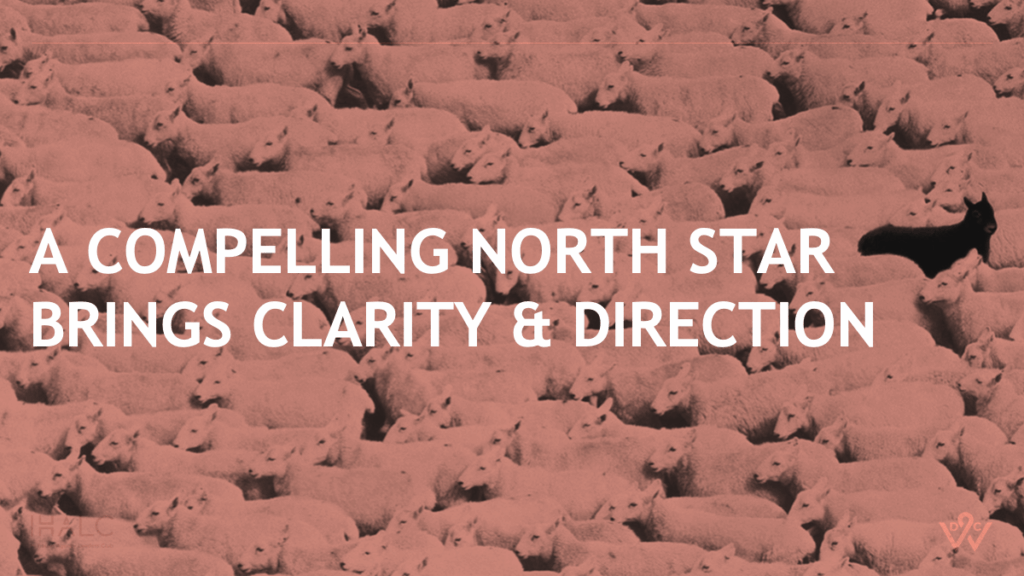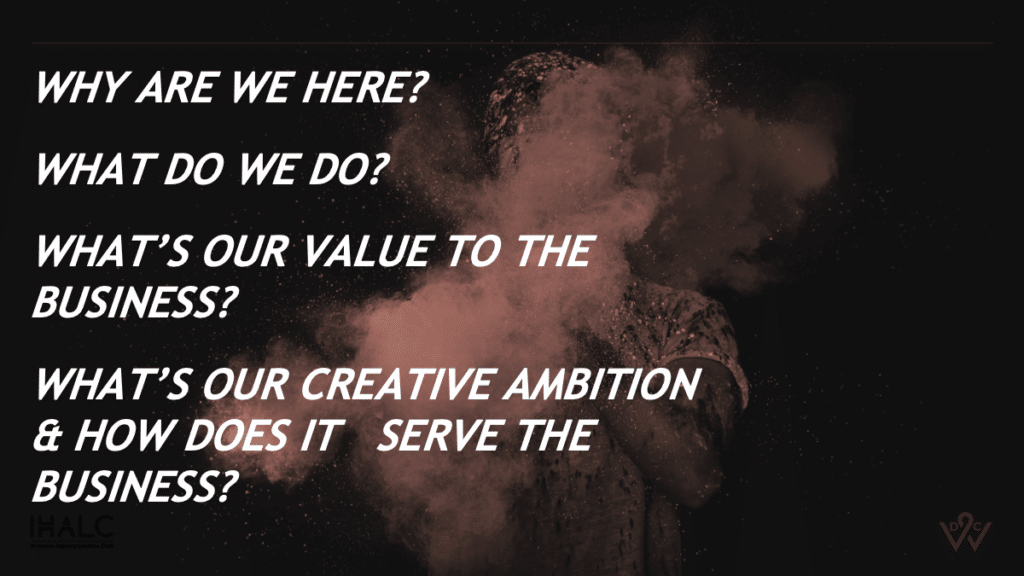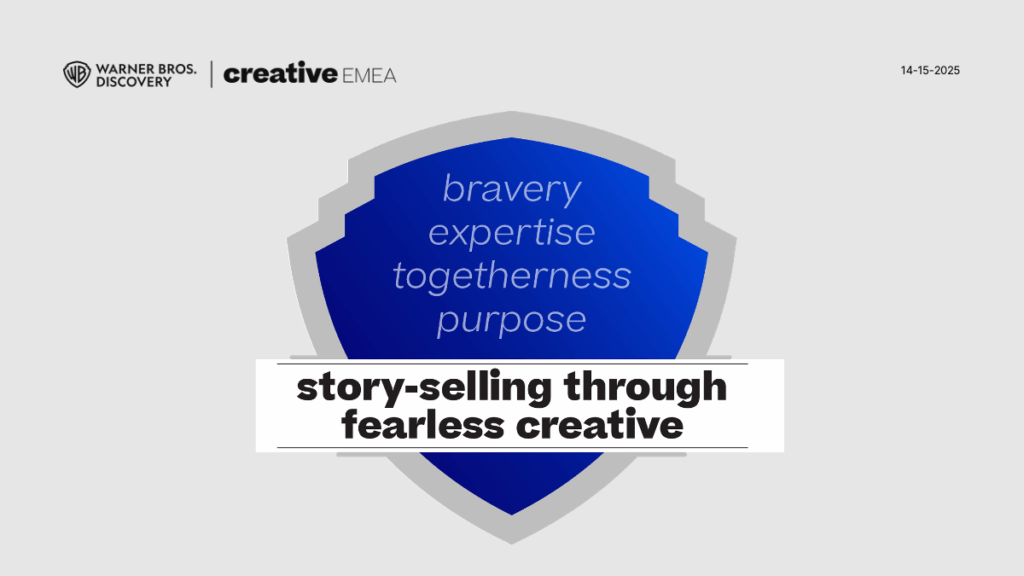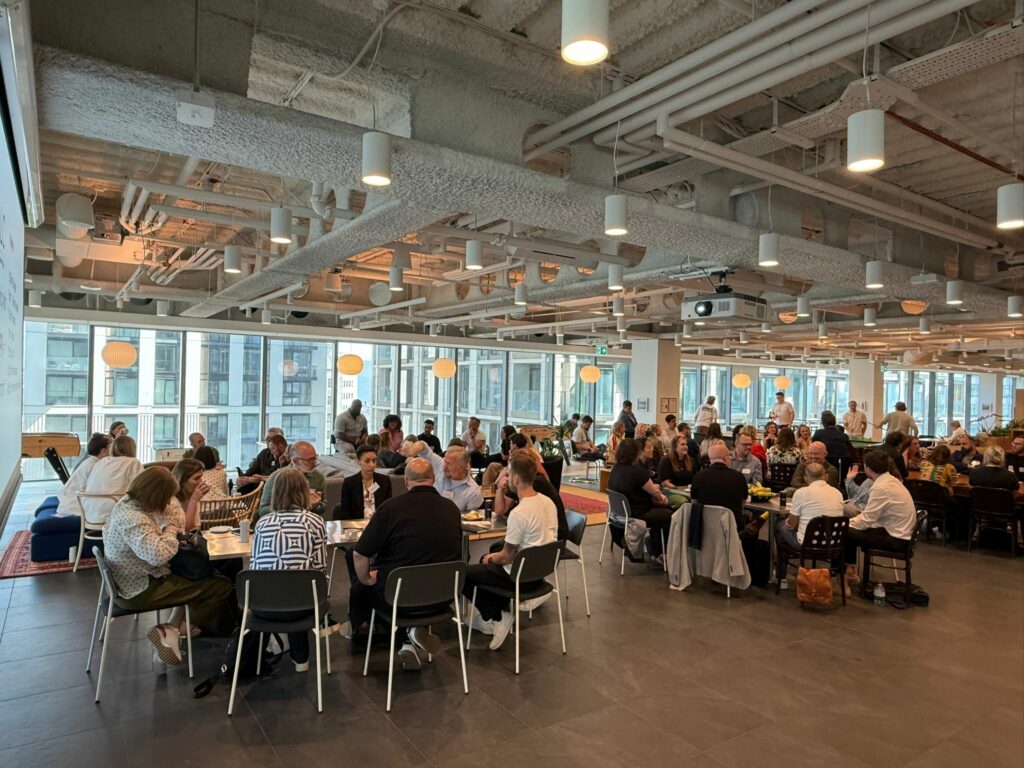As an in-house team, defining a purpose and uniting behind it can be key, both for your own success and in that of the business. A clear, achievable North Star that aligns your values brings clarity and direction, allowing you to answer the big questions, such as ‘why are we here?’ and ‘what’s our value to the business’?


At the IHALC One-Day Summit on 14 May, we explored the value of a North Star with WDC’s Tom Bedwell walking the audience through the process of helping an in-house team define theirs. Last autumn, WDC worked with Warner Brothers Discovery to workshop a manifesto and North Star for their creative team. Emma Cassidy and Andrew Iacovides from WBD Creative walked us through the process and the work they have done to embed and enact the values they landed on at the workshop (shown top).

We then went into round table discussions around North Stars, purpose, and identity within in-house creative teams.
The discussions covered the concept of a “North Star” or a defined purpose, vision, or set of values for in-house creative teams. Many participants acknowledged the value of having such an identity but also revealed that many teams either do not have a formally defined North Star or have struggled to make it truly effective and lived within the team and the wider business.

Challenges in Defining and Living a North Star:
One common experience is that the North Star or values are developed in a workshop, everyone gets excited, but then it “ends up in a drawer” and is forgotten.
This can happen if the definition is too wordy, abstract, or tries to be too many different things – like a “Swiss Army knife” – making it hard to action.
If the North Star is developed in a silo, without input from the team members who have to embody it daily, they won’t believe in it or spread the message. It needs to be “genuinely grassroots” to take root.
Constant change, restructures, and churn within the business can make it difficult to establish and maintain a consistent identity.
Achieving buy-in and alignment from the rest of the business is a significant challenge; it’s not automatic. Teams often have to work hard to prove their value through action.
It’s hard to make the North Star feel real, tangible, and something people live every day. Continuous reinforcement and celebration are necessary, not just a one-off exercise.
The North Star needs to be robust and not solely dependent on the vision of a single leader.
Perceived Benefits and Purpose of a North Star:
- A clear North Star helps create a distinct identity and culture for the team. This can help the team feel more supported and empowered.
- It can help attract talent by presenting the in-house team as having a culture similar to external agencies.
- It serves as a tool for alignment, both internally within the creative team and externally with stakeholders, marketers, and other departments.
- It provides a framework for decision-making, helping the team understand what kind of work they should be doing and how to prioritize.
- It can help the team define its value proposition and remit within the organization.
- It connects the team’s work to broader business outcomes and the company’s journey. For example, one team’s North Star was linked to solving problems for their energy company.
- A North Star can act as a “scorecard” or criterion for evaluating work, ensuring it aligns with the team’s aspirations (e.g., evaluating based on “bravery”).
- It fosters a sense of belonging and can help teams navigate difficult or turbulent times.
Relationship with the Wider Business and Stakeholders:
A key point is that in-house teams are well-placed to share the objectives of their internal partners.
However, in-house teams often face the challenge of being perceived as a “service provider,” “sausage factory,” or “demand centre” focused primarily on speed and cost-saving, rather than a strategic creative partner. This perception needs to shift towards seeing the team as adding value through creativity and strategic thinking.
There’s a need to educate the wider business about the value and process of creativity, as it can be seen as complex or misunderstood (“voodoo”) by those outside the creative function.
Building trust and strong relationships with stakeholders is fundamental for the in-house team’s success.
Demonstrating the team’s value can involve showing “little wins” and using data (KPIs, effectiveness, efficiencies) to prove impact.
Managing the high demand from stakeholders who view the team as an “all you can eat buffet” is a constant battle. Strategies discussed include having candid conversations about priorities, implementing tiering systems for requests, setting expectations upfront, and even attaching costs or rate cards to work to illustrate resource allocation and manage demand.
Some teams are actively trying to change this perception by having internal roadshows, showcasing their work, and bringing stakeholders into the creative process to help them understand what it takes.
Team Culture and Behaviours:
The North Star or team identity directly influences team behaviours and helps create the desired culture.
Defining brave or fearless behaviours is crucial, especially in corporate environments that often prioritize safety. It’s also important to recognize when pragmatism is necessary.
Collaboration is seen as a key behaviour for breaking down silos and improving work quality. “Unconditional collaboration” was highlighted as a team mindset.
Fostering a “builds culture” in meetings and reviews is important, where ideas are explored and built upon rather than shut down prematurely.
Developing “soft skills” like stakeholder management and navigation is essential for in-house teams working closely with various internal partners.
Finding ways to celebrate work and creative passion, even if the final client output differs from the creative vision (e.g., creating internal “director’s cuts”), can boost team morale.
Defining what the team is “against” (e.g., against old habits or tropes) can be as valuable as defining what it is “for”.
Team principles should be specific to the creative team’s work and distinct from generic company values.
In summary, while many in-house creative teams aspire to or have attempted to define a North Star, the challenge lies in making it a living, breathing part of the team’s culture and successfully communicating its value and purpose to the wider organization to shift perceptions and manage expectations. This requires genuine team ownership, continuous effort, and strategic engagement with stakeholders.
IHALC and WDC can help your team workshop its North Star via a bespoke One-Day Workshop. Contact patrick.burgoyne@ihalc.com for details
